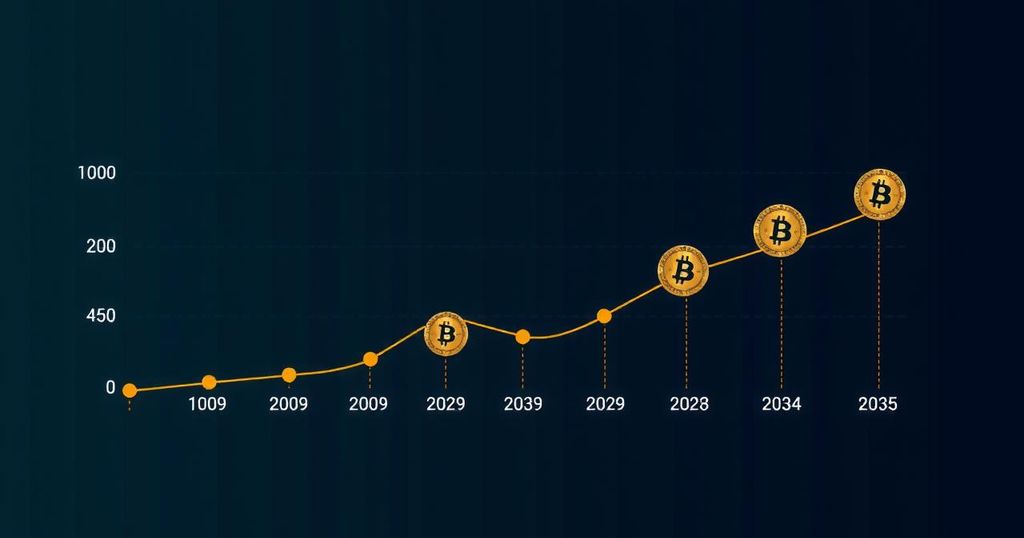An Examination of Bitcoin’s Price Evolution: 2009-2024
Bitcoin is a groundbreaking digital currency that has significantly altered the financial landscape, capturing the interest of millions across the globe. Its remarkable journey from obscurity to widespread recognition has been extraordinary. This blog post delves into Bitcoin’s price history from 2009 to 2024, examining the critical events, trends, and factors that have influenced its volatile value over the years.
### Factors Affecting Bitcoin’s Price
Several factors fundamentally influence the value of Bitcoin and other cryptocurrencies:
1. Supply and Demand: The core principle of supply and demand greatly impacts Bitcoin’s price. The Bitcoin protocol limits the total supply to 21 million coins, which, coupled with varying demand—driven by investor interest, adoption rates, and macroeconomic conditions—leads to significant price fluctuations. Additionally, the adjustments in mining difficulty influence how quickly new coins are made available in the market.
2. Competition from Other Cryptocurrencies: Bitcoin faces competition from a wide array of alternative cryptocurrencies. New blockchain projects that offer distinctive features and applications can draw investor capital away from Bitcoin.
3. Halving Events: Bitcoin’s issuance schedule includes periodic halving events, occurring approximately every four years, which reduce the creation rate of new coins. These events enhance scarcity and emulate the mining process of precious metals. Historically, halving events have precipitated price rallies due to expectations of constrained supply and escalating scarcity.
4. Introduction of New Financial Instruments: The emergence of new investment products linked to Bitcoin—such as exchange-traded funds (ETFs), futures contracts, and specialized custody solutions—can significantly affect its price dynamics. These vehicles furnish traditional investors with means to engage with Bitcoin without direct ownership of the asset.
### Bitcoin’s Price History (2009-2024)
Bitcoin’s journey as a medium of exchange has been characterized by notable ups and downs. Below is a summary of its price milestones:
– Current Bitcoin price (as of September 9, 2024): $55,789.30
#### Yearly Price Highlights:
– 2024: High – $73,750; Low – $39,800
– 2023: High – $42,500; Low – $16,000
– 2022: High – $47,835; Low – $18,490
– 2021: High – $68,789; Low – $29,796
– 2020: High – $29,096; Low – $3,850
– 2019: High – $13,017; Low – $3,401
– 2018: High – $18,343; Low – $3,217
– 2017: High – $19,892; Low – $784
– 2016: High – $981; Low – $351
– 2015: High – $465; Low – $172
– 2014: High – $13; Low – $310
– 2013: High – $1,163; Low – $13
– 2012: High – $16; Low – $4
– 2011: High – $32; Low – $0.29
– 2010: High – $0.40; Low – $0.00
– 2009: High – $0.0041
#### Price History Overview (2009-2015)
In 2009, Bitcoin’s value was inconsequential, with initial transactions establishing informal valuation standards. By 2010, recorded market valuations emerged, indicating a price of around $0.003. Significant volatility marked 2011, where prices surged past $1 before a mid-year drop to approximately $0.30, ultimately reaching $31 by year-end. The years 2012 to 2013 were characterized by steady growth, culminating in Bitcoin surpassing $1,000 in November 2013. However, the bear market in 2014 saw prices decrease to around $300, influenced by regulatory concerns and security vulnerabilities. The year 2015 recorded trading between $200 and $500, reflecting growing acceptance.
#### Price History Overview (2016-2020)
Bitcoin commenced 2016 at approximately $430, concluding at about $970, indicating consistent growth. The year 2017 was pivotal, as Bitcoin soared to nearly $20,000 by December due to an unprecedented bull market. The market corrected sharply in 2018, with Bitcoin languishing around $3,200 by year-end, while 2019 witnessed a recovery to about $7,200. In 2020, amidst the COVID-19 pandemic, Bitcoin exhibited resilience, fluctuating between $5,000 and $10,000, ultimately closing at around $29,000.
#### Price History Overview (2021-2024)
In 2021, Bitcoin ascended from approximately $29,000 to over $60,000 in April, propelled by institutional interest. However, it fluctuated between $30,000 and $60,000, concluding the year around $46,000. The year 2022 saw continued fluctuations resulting in an end near $45,000, influenced by regulatory and environmental issues. In 2023, Bitcoin prices ranged from $40,000 to $60,000, closing around $55,000. By January 2024, the regulatory landscape shifted with the approval of Bitcoin ETFs, resulting in significant market activity and increases in Bitcoin’s valuation, which peaked at $73,805 in mid-March 2024.
### Major Historical Events Influencing Bitcoin’s Price
Significant milestones that have shaped Bitcoin’s value include:
– Genesis Block Creation (2009): Bitcoin’s inception began on January 3, 2009, with the mining of its Genesis block.
– Bitcoin Pizza Day (2010): A programmer’s purchase of two pizzas for 10,000 BTC highlighted Bitcoin’s practical utility.
– Mt. Gox Hack (2011): The theft of 850,000 bitcoins from the largest exchange at the time drastically affected market confidence.
– Silk Road Shutdown (2013): Regulatory actions against the Silk Road diminished demand for Bitcoin amid negative publicity.
– First Bull Run (2013): Bitcoin soared past $1,000, driven by media coverage and speculative trading.
– China’s Ban on Exchanges (2017): This regulatory move triggered significant market sell-offs, resulting in price declines.
– Institutional Adoption (2020-2021): Initiatives contributing to Bitcoin’s acceptance as a store of value included corporate investments and endorsements, such as Tesla’s $1.5 billion purchase in 2021.
– Bitcoin ETF Launch (2024): The introduction of Bitcoin ETFs marked a significant development in legitimizing Bitcoin as an investment vehicle, enabling easier access for both retail and institutional investors.
In conclusion, Bitcoin’s price history paints a picture of a volatile yet resilient digital asset, shaped by numerous internal and external factors over time. As the cryptocurrency market evolves and regulatory frameworks develop, the future of Bitcoin continues to intrigue investors and analysts alike.








Post Comment